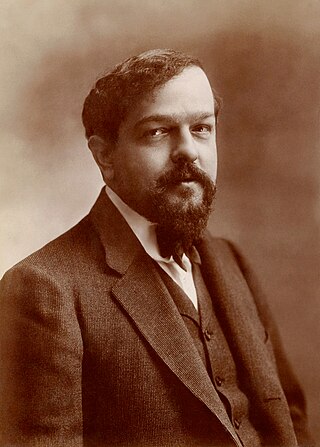
(Achille) Claude Debussy was a French composer. He is sometimes seen as the first Impressionist composer, although he vigorously rejected the term. He was among the most influential composers of the late 19th and early 20th centuries.

Eric Alfred Leslie Satie, who signed his name Erik Satie after 1884, was a French composer and pianist. He was the son of a French father and a British mother. He studied at the Paris Conservatoire, but was an undistinguished student and obtained no diploma. In the 1880s he worked as a pianist in café-cabaret in Montmartre, Paris, and began composing works, mostly for solo piano, such as his Gymnopédies and Gnossiennes. He also wrote music for a Rosicrucian sect to which he was briefly attached.
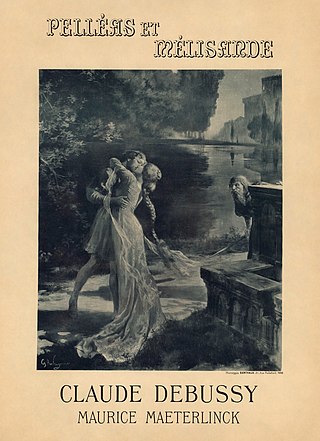
Pelléas et Mélisande is an opera in five acts with music by Claude Debussy. The French libretto was adapted from Maurice Maeterlinck's symbolist play of the same name. It premiered at the Salle Favart in Paris by the Opéra-Comique on 30 April 1902; Jean Périer was Pelléas and Mary Garden was Mélisande, conducted by André Messager, who was instrumental in getting the Opéra-Comique to stage the work. The only opera Debussy ever completed, it is considered a landmark in 20th-century music.
Désiré-Émile Inghelbrecht was a French composer, conductor and writer.

Pelléas and Mélisande is a Symbolist play by the Belgian playwright and author Maurice Maeterlinck. It's about the forbidden, doomed love of the title characters and was first performed in 1893.
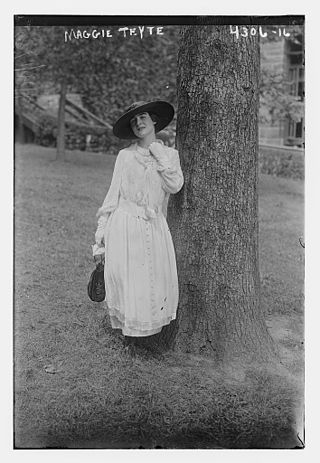
Dame Maggie Teyte was an English operatic soprano and interpreter of French art song.

Pelleas und Melisande, Op. 5, is a symphonic poem written by Arnold Schoenberg and completed in February 1903. It was premiered on 25 January 1905 at the Musikverein in Vienna under the composer's direction in a concert that also included the first performance of Alexander von Zemlinsky's Die Seejungfrau. The work is based on Maurice Maeterlinck's play Pelléas and Mélisande, a subject suggested by Richard Strauss. When he began composing the work in 1902, Schoenberg was unaware that Claude Debussy's opera, also based on Maeterlinck's play, was about to premiere in Paris.
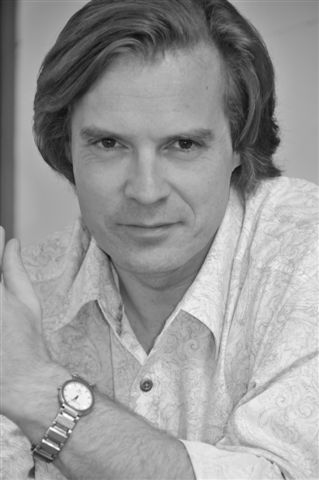
Jean-François Lapointe is a Canadian baritone opera singer.

Pelléas et Mélisande, Op. 80 is a suite derived from incidental music by Gabriel Fauré for Maurice Maeterlinck's play of the same name. He was the first of four leading composers to write music inspired by Maeterlinck's drama. Debussy, Schoenberg and Sibelius followed in the first decade of the 20th century.
Jacques Jansen was a French baryton-martin singer, particularly associated with the role of Pelléas in the opera by Debussy, but also active in operetta and on the concert platform, and later as a teacher.
Didier Henry is a French baritone.

Hector Dufranne was a Belgian operatic bass-baritone who enjoyed a long career that took him to opera houses throughout Europe and the United States for more than four decades. Admired for both his singing and his acting, Dufranne appeared in a large number of world premieres, most notably the role Golaud in the original Opéra-Comique production of Claude Debussy's Pelléas et Mélisande at the Salle Favart in Paris in 1902, which he went on to sing 120 times at that house. He had an excellent singing technique which maintained the quality of his voice even into the latter part of his career. His wide vocal range and rich resonant voice enabled him to sing a variety of roles which encompassed French, German, and Italian opera.

Jeanne Gerville-Réache was a French operatic contralto from the Belle Époque. She possessed a remarkably beautiful voice, an excellent singing technique, and wide vocal range which enabled her to perform several roles traditionally associated with mezzo-sopranos in addition to contralto parts. Her career began successfully in Europe just before the turn of the twentieth century. She travelled to North America in 1907, where she worked as an immensely popular singer until her sudden death in 1915. She is particularly remembered for her portrayal of Dalila in Camille Saint-Saëns' Samson et Dalila, which she helped establish as an important part of the repertory within the United States. She also notably portrayed the role of Geneviève in the world premiere of Debussy's Pelléas et Mélisande in 1902.

Jean (Alexis) Périer was a French operatic baryton-martin and actor. Although he sang principally within the operetta repertoire, Périer did portray a number of opera roles; mostly within operas by Wolfgang Amadeus Mozart and Giacomo Puccini. His career was almost entirely centered in Paris and he had a long association with the Opéra-Comique. He sang in a large number of world premieres, most notably originating the role of Pelléas in Debussy's Pelléas et Mélisande in 1902. In addition to his opera career, Périer appeared in several films between 1900 and 1938.

Félix Vieuille was a French operatic bass who sang for more than four decades with the Opéra-Comique in Paris during the first half of the twentieth century. He created roles in numerous world premieres, most notably portraying Arkel in the original production of Claude Debussy's Pelléas et Mélisande in 1902 which he went on to sing 208 times at that house. He possessed a rich voice and a solid technique which helped sustain his career for a long time. His voice is preserved on a number of recordings made on the Odeon, Lyrophon, and Beka labels.

La chute de la maison Usher is an unfinished opera in one act by Claude Debussy to his own libretto, based on Edgar Allan Poe's 1839 short story "The Fall of the House of Usher". The composer worked on the score between 1908 and 1917 but it was never completed.
La chanson d'Ève, Op. 95, is a song cycle by Gabriel Fauré, of ten mélodies for voice and piano. Composed during 1906–10, it is based on the collection of poetry of the same name by Charles van Lerberghe. It is Fauré's longest song cycle.

"The Devil in the Belfry" is a satirical short story by Edgar Allan Poe. It was first published in 1839.
Roger David Edward Nichols is an English musicologist, critic, translator and author. After an early career as a university lecturer he became a full-time freelance writer in 1980. He is particularly known for his works on French music, including books about Claude Debussy, Olivier Messiaen, Maurice Ravel, Francis Poulenc and the Parisian musical scene of the years after the First World War. Among his translations are the English versions of the standard biography of Gabriel Fauré by Jean-Michel Nectoux and of Harry Halbreich's study of Arthur Honegger.
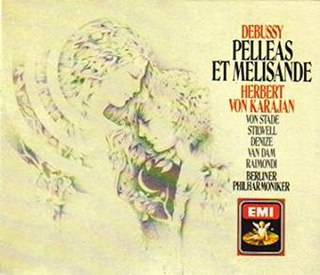
Pelléas et Mélisande is a 162-minute studio album of Claude Debussy's opera, performed by Christine Barbaux, José van Dam, Nadine Denize, Ruggero Raimondi, Frederica von Stade, Richard Stilwell and Pascal Thomas with the Chorus of the German Opera Berlin and the Berlin Philharmonic Orchestra under the direction of Herbert von Karajan. It was released in 1979.















